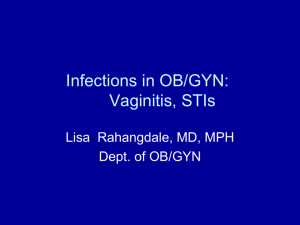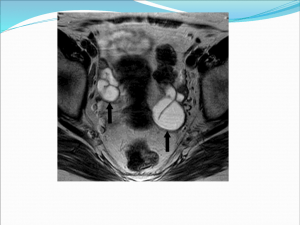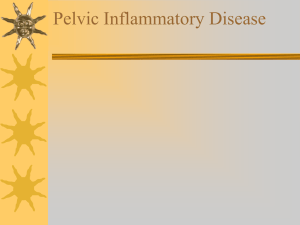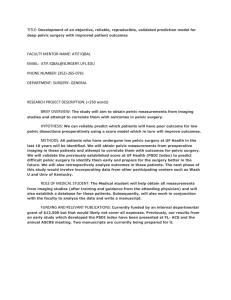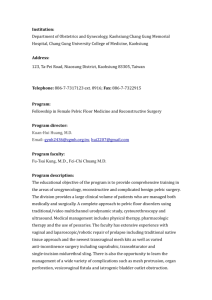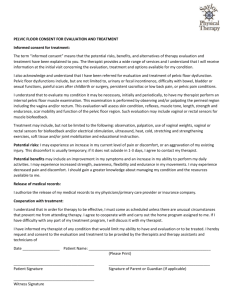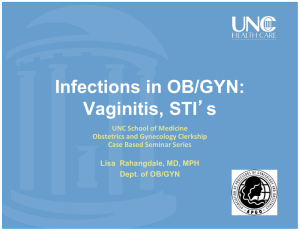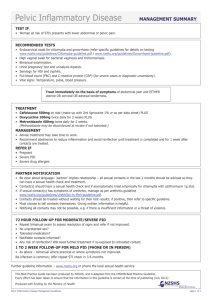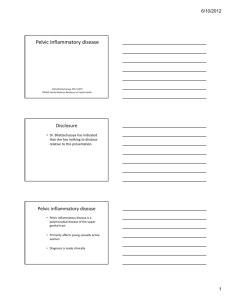Female abdominal pain show notes (Word format)
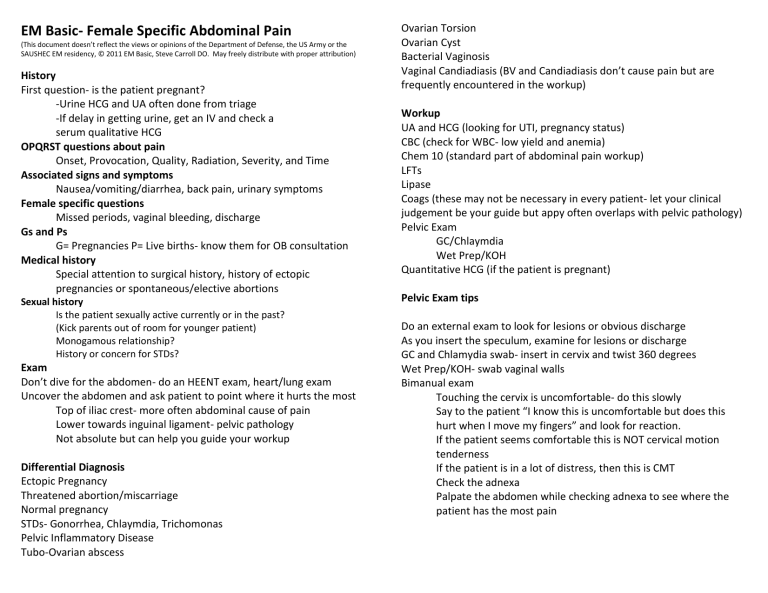
EM Basic- Female Specific Abdominal Pain
(This document doesn’t reflect the views or opinions of the Department of Defense, the US Army or the
SAUSHEC EM residency, © 2011 EM Basic, Steve Carroll DO. May freely distribute with proper attribution)
History
First question- is the patient pregnant?
-Urine HCG and UA often done from triage
-If delay in getting urine, get an IV and check a serum qualitative HCG
OPQRST questions about pain
Onset, Provocation, Quality, Radiation, Severity, and Time
Associated signs and symptoms
Nausea/vomiting/diarrhea, back pain, urinary symptoms
Female specific questions
Missed periods, vaginal bleeding, discharge
Gs and Ps
G= Pregnancies P= Live births- know them for OB consultation
Medical history
Special attention to surgical history, history of ectopic pregnancies or spontaneous/elective abortions
Sexual history
Is the patient sexually active currently or in the past?
(Kick parents out of room for younger patient)
Monogamous relationship?
History or concern for STDs?
Exam
Don’t dive for the abdomen- do an HEENT exam, heart/lung exam
Uncover the abdomen and ask patient to point where it hurts the most
Top of iliac crest- more often abdominal cause of pain
Lower towards inguinal ligament- pelvic pathology
Not absolute but can help you guide your workup
Differential Diagnosis
Ectopic Pregnancy
Threatened abortion/miscarriage
Normal pregnancy
STDs- Gonorrhea, Chlaymdia, Trichomonas
Pelvic Inflammatory Disease
Tubo-Ovarian abscess
Ovarian Torsion
Ovarian Cyst
Bacterial Vaginosis
Vaginal Candiadiasis (BV and Candiadiasis don’t cause pain but are frequently encountered in the workup)
Workup
UA and HCG (looking for UTI, pregnancy status)
CBC (check for WBC- low yield and anemia)
Chem 10 (standard part of abdominal pain workup)
LFTs
Lipase
Coags (these may not be necessary in every patient- let your clinical judgement be your guide but appy often overlaps with pelvic pathology)
Pelvic Exam
GC/Chlaymdia
Wet Prep/KOH
Quantitative HCG (if the patient is pregnant)
Pelvic Exam tips
Do an external exam to look for lesions or obvious discharge
As you insert the speculum, examine for lesions or discharge
GC and Chlamydia swab- insert in cervix and twist 360 degrees
Wet Prep/KOH- swab vaginal walls
Bimanual exam
Touching the cervix is uncomfortable- do this slowly
Say to the patient “I know this is uncomfortable but does this hurt when I move my fingers” and look for reaction.
If the patient seems comfortable this is NOT cervical motion tenderness
If the patient is in a lot of distress, then this is CMT
Check the adnexa
Palpate the abdomen while checking adnexa to see where the patient has the most pain
Imaging
PEARL- HUGE overlap between pelvic and abdominal pathology- keep your differential open
Transvaginal Pelvic ultrasound- helpful in suspected ectopic pregnancy
(covered in a later podcast). Should see IUP at HCG of approximately
1,500
Ovarian Torsion- “Classic”- Sudden onset of sharp stabbing pain in lower abdomen with nausea or vomiting.
PEARL- A negative pelvic ultrasound DOES NOT rule out torsion
Intermittent torsion is possible
Time sensitive diagnosis- ovary salvage rate greatly declines after
4 hours
High suspicion= OB/GYN consult and admission for observation
Most torsions have large cysts but not all
PEARL- If radiologist doesn’t want to do TVUS after hours because “an ultrasound doesn’t rule out torsion”, say you are concerned for tuboovarian abscess or large hemorrhagic cyst
Ovarian Cyst- Cyst on same side as pain with good blood flow to ovary
Can be discharged with pain control, OB/GYN followup
STDs
Treatment depends on how fast your GC/Chlamydia test is
Send-out = Empirically treat all patients with discharge and/or CMT
PEARL- ALWAYS treat for gonorrhea and chlamydia
(Often co-exist and missing it can have long term fertility consequences)
Cervicitis treatment (no CMT but positive swab)
Ceftriaxone 125mg IM
1 gram of azithromycin PO x1 dose
(PCN or cephalosporin allergic- 2 grams azithromycin PO x1)
PID treatment (CMT and/or discharge)
Ceftriaxone 250mg IM
Doxycycline 100mg PO BID for 14 days
PEARL Admit patients who are ill appearing, pregnant, unresponsive to outpatient treatment, PO intolerant
Caution patient to not have sex for seven days after treatment stopped and to get partner tested to avoid re-infection
Fitz-Hugh Curtis- PID infection that has spread to the liver capsule and causes perihepatitis- may have RUQ pain and tenderness, right shoulder pain. LFTs may be elevated but not always. Treatment is to treat for PID
Tubo-Ovarian Abscess- non-specific symptoms- abdominal/pelvic pain, history of STDs, severe or recurrent PID. Usually untreated PID that has formed an abscess. Diagnosed with TVUS, treated with IV abx, surgical drainage
Trichomonas- Motile organisms on Wet Prep. Sxs- itching, discharge, dysuria dyspaurenia
Treatment- Flagyl 2 grams PO x1 or 500mg PO BID for 7 days
Treat partner as well- men are often asymptomatic
No alcohol while on flagyl (disulfaram reaction = vomiting)
Bacterial Vaginosis- not an STD but frequently diagnosed- overgrowth of
Gardanella Vaginalis. Sxs- malodorous diascharge. Clue cells on Wet Prep
Treat all symptomatic patients AND pregnant patients
Treatment- Flagyl 2 grams PO or 500mg PO BID for 7 days
Candiadiasis- “yeast infection” usually after abx. Fungal elements on Wet Prep.
Treatment- Fluconazole- 150mg PO x1 or topical treatments
Topical treatments can control sxs better, can use with fluconazole
PEARL- with all pelvic swabs- false negatives occur so treat clinically for what you think is the most serious cause
How to approach positive STD tests- Sometimes women will be suspicious for
STDs, sometime not. Have a frank discussion of what you found and what it means. Talk to the patient alone- if you have to, devise a ruse to get anyone else out of the room (go get the car, go to the pharmacy, sign paperwork, etc.)
Make sure the patient knows that they have an STD but let them know that they could have been asymptomatic for a long time and that you aren’t pointing fingers. Let them know the importance of completing the full course of treatment and following up with their OB/GYN or primary care doctor. Let them know that you aren’t accusing anyone of cheating. Make sure to stress to the patient the importance of getting their partner tested and treated as well.
If you are treating PID empirically (send-out GC/Chlamydia) make sure that the patient knows this and they understand that you are treating them for an STD without knowing whether or not they have one. Make sure you have a good phone number to call the patient back with a positive test result.
Contact- steve@embasic.org
